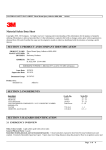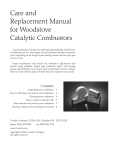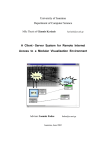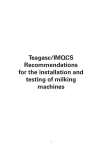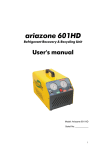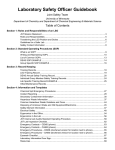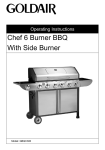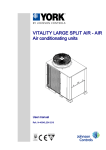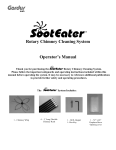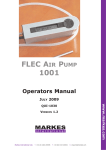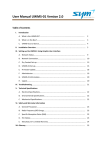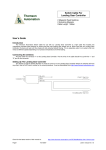Download LGC manual english 1.1 - The University of Hong Kong
Transcript
Hong Kong Oxygen & Acetylene Co. Ltd. User Manual and Safety Information for Industrial Liquid Gas Containers 香港氧氣有限公司 工業用液態氣瓶使用及安全手冊 INDEX 1. 2. 3. INTRODUCTION 1.1 Definition 4 1.2 Scope 5 1.3 Description 5 SAFETY PRECAUTIONS 2.1 General 6 2.2 Oxygen Enrichment and Dilution 7 2.3 Personal Protective Equipment 7 2.4 First Aid 9 STORAGE 3.1 Siting 10 3.2 Storage Compound 10 3.3 Ventilation 11 3.4 Storage License 3.5 Containers in Store 11 3.6 Housekeeping 11 4. HANDLING 5. USE 11 13 5.1 Commissioning 15 5.2 Connection Procedures 15 5.3 Disconnection Procedures 16 5.4 Daily Checks 17 5.5 Pressure Control Valve 17 5.6 Maintenance 18 2 6. EMERGENCY PROCEDURES 6.1 Leaks and Spills 19 6.2 Bursting Disc Failure 19 6.3 When a Container Falls Over or is Dropped 19 6.4 Fire 20 Appendix I - Schematic Diagram of Liquid Gas Container Appendix II - Industrial Liquid Gas Safety handling sheet Appendix III - References 3 1. INTRODUCTION 1.1 Definition Industrial Liquid Gas Containers are defined as portable containers use for the storage and delivery of (fig. 1) liquid oxygen, (fig. 2) liquid nitrogen, (fig. 3) liquid argon or (fig. 4) liquid carbon dioxide. Fig.1 Liquid Oxygen (230 psi) Fig.2 Liquid nitrogen (22/230/350psi) Fig. 3 Liquid Argon (350 psi) Fig.4 Liquid Carbon Dioxide (350psi) 4 1.2 Scope The purpose of this manual is to give persons involved with the use of industrial liquid gas containers concise instructions on safe installation and handling. Liquid containers should not be put into service unless these instructions have been thoroughly read and understood by the user. If there is any doubt as to the meaning of the instructions Hong Kong Oxygen should be contacted for advice. 1.3 Description Liquid gas containers are portable containers for the transport and storage of refrigerated liquid gases. They are of double wall construction with vacuum and multi layer insulation contained between two stainless steel vessels and are suitable for operation at cryogenic temperatures. They incorporate self pressurising equipment and provide a complete, self-contained gas supply system. Industrial liquid gas containers are designed to dispense gases in liquefied or gaseous form, although it is stored in the container in liquid form. Liquid gas containers can be used singly/ individually, or to provide a continuous gas supply by being connected to a manifold with a changeover device, which can be either automatic or manual. 5 2. SAFETY PRECAUTION 2.1 General (a) Only experienced and properly instructed persons should handle liquid gas containers and be responsible for them when stored. (b) Anyone using gases contained in liquid gas containers should know and understand the properties and hazards of the particular gas being used before using it. For this purpose, Safety Data Sheets are provided by Hong Kong Oxygen (See Appendix II of this manual) and further copies may be obtained by calling Hong Kong Oxygen (c) The labels on a liquid gas container are a statutory requirement and they provide important information for the user. They must not be defaced or removed. (d) Before using liquid gas containers establish plans to cover any emergency situations that might arise such as fire, leaks and spills. Refer to Section 6 of this manual. (e) Smoking and the use of open flames in the vicinity of a liquid gas container should be prohibited. (f) When any doubt exists as to the correct handling, storage or use of a liquid gas container contact Hong Kong Oxygen for advice. 6 2.2 Oxygen Enrichment and Dilution The atmosphere normally contains about 21% by volume of oxygen. Enrichment may give rise to a significant increase in the rate of combustion, even at concentrations as low as 23%. Flammable items will burn vigorously and could explode in oxygen. Oils, grease, tarry substances, kerosene, cloth and many plastics are particularly dangerous in contact with oxygen. Many materials which are not flammable in air, such as common metals, may burn in an oxygen enriched atmosphere. Spillage or leakage of nitrogen, argon or carbon dioxide may lead to dilution of the level of oxygen in air. This can cause asphyxiation. Symptoms of asphyxiation are drowsiness, rapid and gasping respiration, accelerated pulse rate and muscular incoordination. Prolonged exposure may result in nausea and vomiting and eventually lead to loss of consciousness and death. These symptoms do not give adequate warning of reduced oxygen levels, and exposure to reduced Eoxygen levels may result in loss of consciousness without other symptoms being experienced. Carbon dioxide at levels up to about 5% acts as a stimulate to respiration, and may cause hyperventilation. Equipment containing liquified nitrogen or argon may became sufficiently cold to cause liquid oxygen to condense on the surface of the equipment, causing potential localised enrichment of air. Extreme care must always be taken during the handling, storage and use of liquid gases to prevent oxygen enrichment or depletion. Adequate ventilation is essential. 2.3 Personal Protective Equipment The appropriate personal protective equipment should be worn by all persons handling liquid gas containers. Liquefied oxygen, nitrogen, argon and carbon dioxide and the materials in contact with them are very cold. They can produce frostbite on skin and exposed eye tissue. Contact with extremely cold materials will cause the flesh to stick fast and tear when withdrawn. Never allow liquefied nitrogen, oxygen, argon and carbon dioxide to contact any part of the body, to touch un-insulated pipes or vessels which 7 contain these liquid gases or cold gaseous products. Follow the guidelines given below for the use of personal protective equipment:- (a) When handling any part of the container or downstream equipment that may be cold gloves must be worn. Gloves should be non-absorbent leather, preferably insulated, and of loose fit so that they can be easily removed. Sleeves should cover the end of the gloves. Gauntlet gloves are not recommended because liquid can drip into them. (b) Safety glasses or goggles should be worn to protect the eyes during transfer and normal handling of liquid gases in liquid gas containers. Where spraying or splashing of liquid may occur, such as during liquid withdrawal to an open warm vessel, a face shield should be worn for additional protection. (c) Overalls or similar types of clothing are recommended. These should be loose fitting and without open pockets or turn ups where liquid could collect. Trousers should be worn outside boots for the same reason. 8 (d) Clothing saturated with oxygen is readily ignitable and will burn vigorously. Woven materials for clothing and gloves should be avoided because they can more readily become saturated with cold liquids and gases. If clothing does become contaminated with liquid gases or vapours, the wearer should preferably remove it and air it well for at least an hour. If this is not possible, ventilate it by walking around in a well ventilated area, preferably in the open air. The wearer should not smoke or approach any naked flame for one and a half hours. (e) It is strongly recommended that any person handling liquid gas containers shall wear safety boots or shoes. 2.4 First Aid Personnel will rarely come in contact with the liquid gases if the proper procedures for handling and use are followed. In the event that any person experiences direct contact with the liquid, medical assistance should be sought immediately. Any clothing that may restrict circulation to the frozen area should be removed and the affected part of the body should be placed in a warm water bath not exceeding a temperature of 40 degrees centigrade. The victim should be kept warm. For massive exposure cases resulting in general lowering of the body temperature, the victim must be re-warmed by immersion in the warm water bath. Never use dry heat or rub frozen parts as tissue damage may result. Supportive treatment for shock should be provided. Warm drinks and food may be administered to a conscious victim. When the frozen part of the body has thawed, cover the area with a dry sterile dressing and with a bulky protective covering. 9 3. STORAGE 3.1 Siting Liquid Containers should be stored in a purpose-built compound which should be located away from fire risks and sources of heat and ignition. Licensing requirements usually demand that the store be constructed of two hours fire resistant materials. If the containers are not stored in a two hours fire resistant store they must be separated from flammable gases and liquids and from combustible materials and public places by a distance of at least 5 metres. It is not necessary to use any special type of electrical equipment but no electric cables or electrical equipment of any kind should be allowed to come into contact with the containers. 3.2 Storage Compound The storage compound should protect the liquid gas containers against extremes of weather and against accidental damage. The floor of the store should be level and smooth and constructed of non-porous concrete. Tar and bitumen must not be used. The compound should be clearly marked, in English and Chinese, as to the specific liquid gas in the store and compressed gas and oxidizing substance hazard warning signs should be displayed as well as no smoking notices. 10 3.3 Ventilation It is essential that the storage compound be well ventilated by either natural or mechanical ventilation. If liquid gas containers are stored for several days without being used the internal pressure will rise and the pressure relief valve will open to bring down the pressure. This will release gas into the storage compound. For an enclosed store it is recommended to wait for a short period of time after opening the doors before entering the store, in case there has been any accumulation of gases. 3.4 Storage Licence For the storage of exceeds quality of container, the store is required to be licensed by the Fire Services Department under the Dangerous Goods (General) Regulations (Chapter 295), regulations 62, 63, 77 and 73. The user is responsible for ensuring that these regulations are observed. Advice is available from Hong Kong Oxygen if required. 3.5 Containers in Store Liquid gas containers should be stored in the upright position and should be properly secured to prevent toppling. The containers should be positioned in such a way that discharge from the pressure relief device or bursting disc is not directed onto other equipment or into area used by personnel. Liquid gas containers should be stored in segregated clearly marked area. Full and empty containers should also be separated and the areas clearly designated. It is important to ensure good stock rotation so that the oldest stock is used first. 3.6 Housekeeping The compound and the area immediately surrounding it should be kept clean and tidy. Clear access to the store should be maintained at all times and access should be 11 restricted to authorised persons only. The store should be kept locked and should be inaccessible to members of the public. The containers themselves should be kept clean. In particular, oil, grease or other readily combustible substances and corrosive chemicals should never be allowed to come into contact with the valves, piping and controls. Valve outlets should be kept free from all types of contaminants. 12 4. HANDLING An empty liquid gas container can weight as much as 113 kilograms and when full it can become as heavy as 323 kilograms (weight varies by products). It is therefore essential to handle gas containers carefully. Although the containers approved for use in Hong Kong are designed to withstand rough handling, abuse may damage the containers, rendering them unserviceable, and/ or cause injury to the user. Movement of containers by the user should therefore be avoided wherever possible. When it is necessary for a container to be moved, by the user, hand carts or other mechanical handling devices must be used, even for very short distances. The guidelines set out below should be followed. (a) Hand carts should be especially designed to carry liquid gas containers and purpose built. Suitable models can be obtained through Hong Kong Oxygen if required. (b) Fork-lift trucks can be used only in conjunction with a purpose designed pallet or frame. (c) The handling ring on the top of the container must not be used for lifting. Lifting posts are provided on either side of the container top should it be necessary to lift it by means of an overhead hoist. (d) The level gauge protector, piping and other gauges are not designed to be used for handling or lifting the container. Only the handling ring should be used when manoeuvring the container on and off the hand cart, pallet or frame. 13 (e) During movement keep container as upright as possible. Never lay, stored or moved a liquid gas container on its side. (f) Liquid gas containers should not be subjected to excessive mechanical shocks as this may cause damage to valves, safety devices and the vessel itself. Special care should always be taken to prevent the gas container from being dropped or falling over but should this ever happen refer to section 6.3 of this manual for the procedure to follow. 14 5. USE 5.1 Commissioning Before connecting a liquid gas container to a manifold or downstream equipment for the first time the complete system should be checked and tested by Hong Kong Oxygen or another Approved Person. This is usually carried out in conjunction with the licensing procedures. It is essential that materials suitable for the temperatures, pressures and properties of the liquid gas be used and that the system be completely dry. Do not put the system into service unless it has first been thoroughly checked by a competent person. 5.2 Connection Procedure Before a liquid gas container is connected to the manifold or user's equipment check that :- (a) all labels on the liquid gas container refer to the required liquid gas and are in good condition, (b) the liquid gas container is clean, free from leaks and appears to be in good condition. - The pressure should generally be between 500 and 1200 kPa (75 and 175 psig). - It should never exceed, - 1585 kPa (230 psig) for oxygen, argon and 14S nitrogen, - 2500 kPa (350 psig) for carbon dioxide and 14W nitrogen - 154 kPa (20 psig) for a 14T nitrogen container. (Refer to Appendix I for a schematic line diagram of the liquid gas container showing the flow schematic and details of the controls assembly), (c) the manifold and downstream equipment are in good condition and there are no apparent leaks, (d) there is no means by which gas from the downstream system can back feed into the liquid gas container, 15 (e) if connecting direct to user's equipment, the receiving equipment should be checked to ensure that it is capable of standing the maximum discharge pressure of 850 kPa or that a pressure regulating device is fitted. HKO can supply a suitable regulator if required. Note: for gas containers being used outside of the licensed store, all the principles of safe storage as stated in Section 3 of this manual should be followed. If all the above checks are satisfactory proceed to connect the liquid gas container to the manifold or equipment using a purpose made transfer line. Ensure that the line has the correct end connections and never use adaptors to fit the line to the container. Suitable transfer lines can be obtained through Hong Kong Oxygen if required. The use of fittings and jointing materials or compounds should not be necessary but under no circumstances should any such materials be used unless they have been approved for use with the gas by Hong Kong Oxygen. To supply gaseous product, connect the transfer line to the "Gas Use" fitting on the container. Then open the "Pressure Building Valve” and the "Gas Use Valve”. The pressure will attain the preset operating pressure within a few minutes and will maintain this pressure until the container has been emptied. Check the transfer line connections for leaks. The preset operating pressure of the Pressure Building Valve is factory set and user should not tune the setting by themselves. 5.3 Disconnection Procedure When the container is empty or withdrawn from use for any other reason, even on a temporary basis, close all valves tightly. This instruction applies even if the liquid container is to remain connected to a manifold or other downstream equipment. Before disconnecting the transfer line from the manifold or downstream equipment ensure that any pressure in that section of the system, including the transfer line itself, has been safely vented. If the pressure in the line does not reduce check that the liquid gas container valves are tightly closed. 16 5.4 Daily Checks The user should check the following on a daily basis and should keep a record of such checks:- (a) contents are adequate for expected use. (b) pressure gauge is indicating and the pressure is within the normal operating ranges: - below 153 kPa (21 psig) for 14T nitrogen - below 1,580 kPa (below 230 psig) for 14S nitrogen and oxygen. - 700 to 2500 kPa (100 to 350 psig) for 14W nitrogen and carbon dioxide. (c) liquid gas container appearance is normal with no indication of damage and no signs of gas leaks from valves, piping, instruments, transfer lines, manifold or downstream equipment. Frost patches on the body of a liquid gas container indicate high withdrawal rates or defective insulation. Unless it is known that withdrawal has been exceptionally high, Hong Kong Oxygen should be contacted if frosting appears on the body of the container. 5.5 Pressure Control Valve If the pressure control valve on the liquid gas container (for 230 psi and 350 psi container) is found to be passing gas then the vent valve should be opened until the pressure in the container drops below 800 kPa (116 psig). At this point the vent valve should be closed. The pressure in the container should then rise to the preset operating pressure of approximately 850 kPa (123 psig) for 14S nitrogen, oxygen or argon or 2100 kPa (300 psig) for 14W nitrogen or carbon dioxide and remain at this pressure. Should the problem persist repeat the procedure of opening the vent valve to reduce the pressure, up to three times, as necessary. If the pressure still rises significantly above the operating pressure after the vent valve is closed contact Hong Kong Oxygen. Care must be taken not to stand in front of the vent valve when operating it to release pressure as the gas coming out of the vent will be extremely cold and may cause injury. The danger of oxygen enrichment or dilution in the atmosphere is also very high during venting. The area must be ventilated as much as possible throughout this operation. 17 If the rate of consumption is so low that venting is routinely required then an automatic venting system can be connected to the vent valve for enhanced safety. Hong Kong Oxygen can advise on the installation of such a system. For an enclosed store it is recommended that the automatic venting system discharge to a safe area outside the storage compound. 5.6 Maintenance Maintenance of liquid gas containers shall only be carried out by Hong Kong Oxygen. The user should not attempt to repair, modify or adjust any of the controls or piping. In the event of any difficulty in operation call Hong Kong Oxygen for assistance. The user should maintain the storage compound in a clean and tidy condition, should ensure that all safety and warning notices are in place and can be easily read and should maintain all fire fighting equipment in good condition. It is also the responsibility of the user to maintain full compliance with any other requirements imposed as conditions of any dangerous goods storage licences. 18 6. EMERGENCY PROCEDURES 6.1 Leaks and Spills Whenever there is a leak of cold gas or liquid the moisture in the atmosphere will condense creating a highly visible fog. The fog normally extends over a larger area than the gas or vaporizing liquid. The fog will severely reduce visibility and make it difficult to move around safely. All personnel should be evacuated well outside the foggy area and nobody should attempt to enter the fog, even for the purpose of stopping the leak, unless properly trained and equipped to do so. If required, Hong Kong Oxygen can be called to assist with the problem. They should be given full details of the situation so that appropriately trained and equipped personnel can be dispatched. Otherwise the area should be kept well ventilated and remedial work to stem the flow of liquid or gas should not be undertaken until it is safe to do so. If the leak or spill is due to a fault with the liquid gas container Hong Kong Oxygen should be informed immediately. 6.2 Bursting Disc Failure Should the bursting disc on the liquid gas container rupture, releasing a large quantity of gas into the storage compound, inform Hong Kong Oxygen immediately. If the container can be reached safely then the vent valve should be opened and all other valves closed. If in doubt, do not touch the container. Maintain maximum ventilation of the area. For an enclosed store open the doors to increase ventilation. Keep the surrounding area for a distance of 10 metres clear of personnel and naked flames and await the arrival of Hong Kong Oxygen personnel. 6.3 When a Container Falls Over or is Dropped 19 (a) clear the surrounding area for a distance of 10 metres, (b) wait for fifteen minutes. If after this time there is no evidence of frosting on the outer shell or no other abnormal appearance carefully raise the container to the vertical position. Identify the liquid gas container with a tag and contact Hong Kong Oxygen to inspect it for damage. If frosting on the outer shell of the gas container, or any other abnormal condition, is observed do not touch the container. Keep the surrounding area cleared and immediately advise the situation to Hong Kong Oxygen who will dispatch specially trained staff to deal with the damaged gas container. 6.4 Fire In the event of fire in or near the liquid gas container storage compound:- (a) raise the alarm or call the fire brigade and start to fight the fire in accordance with site emergency procedures, (b) everyone not actively engaged in fighting the fire should be evacuated from the immediate danger area, (c) heat from a fire can cause liquid gases to vaporise more rapidly which will increase the pressure in the container and may result in venting of gas through the pressure relief device or the bursting disc. Fire fighters should spray water on the outer vessel of the container, from a safe distance, to keep it cool and structurally intact, (d) care must be exercised when using water to fight a fire involving refrigerated gases. The indiscriminate use of water on cold surfaces can lead to heavy icing and possible blockage of pressure relieve devices or in-operability of valves, (e) call Hong Kong Oxygen for further advice if required, (f) if a liquid gas container has in any way been affected by a fire Hong Kong Oxygen must be advised so that the integrity of the container can be checked before it is continued in service. 20 Appendix I Schematic Diagram of Liquid Gas Container 1. Liquid Valve 11. Gas Use Valve 2. Economiser Regulator 12. Cross Connector 3. Vent Valve 13. Male Elbow 1 / 4” 4. Bursting Disc. 14. Male Elbow 3 / 8” 5. Pressure Gauge 15. Dust Cap 1 / 2“ 6. Pressure Control Valve 16. Male Connector 1 / 2” or 5 / 8” 7. Pressure Building Regulator 17. Gas Connector CGA-580 or CAG-540 8. Pressure Building Valve 18. Dust Cap CGA-580 or CGA-540 9. Liquid Level Gauge 19. Pump Out Cap 10. Vacuum Bursting disc Flow Schematic Controls Assembly 21 Appendix II Safe Handling, Use and Storage of Liquid Gas Containers The following practices are recommended for the safe handling and storage of liquid gas containers. Additional precautions may be necessary depending upon the category to which the gas belongs (corrosive, toxic, flammable, pyrophoric, oxidant, radioactive or inert), the individual properties of the gas, and the process in which it is used. General 1 Only experienced and properly instructed persons should handle liquid gas containers. 2 Observe all regulations and local requirements regarding the storage of liquid gas containers. 3 Do not remove or deface labels provided by HKO for the identification of the contents. 4 Ascertain the identity of the gas before using it. 5 Know and understand the properties and hazards associated with each gas before using it. 6 Before using liquid gas containers, establish plans to cover any emergency situations that might arise. 7 When doubt exists as to the correct handling procedure, contact HKO. 8 If you own your liquid gas container you must be aware of, and discharge, your statutory obligations with regard to maintenance and testing. 9 Ensure that any driver who collects a liquid gas container from a supplier has been properly instructed in the method of handling liquid gas container and in dealing with any emergency. Handling and use 1 Only use appropriate trolleys, roller bases or overhead hoists correctly attached for transporting liquid gas containers even for a short distance. 2 Liquid gas containers should always be stored and operated in a vertical position. 3 Never lay, store or move a liquid gas container on its side. 4 Check for gas leaks using approved lead detection solution. 5 Ascertain that an adequate supply of water is available for first aid fire fighting in the event of leakage. 6 Before connecting the liquid gas container for use, ensure that back feed from the system into the container is prevented. 7 Before connecting liquid gas containers check the complete gas system for suitability, particularly for pressure rating and materials. 8 Never permit liquefied gas to become trapped in parts of any system as this may result in rupture of the system. 9 Ascertain that all electrical systems in the area are suitable for service with each gas. 10 Never use direct flame or electrical heating devices to raise the pressure of a liquid gas container. 11 Never re-compress a gas or a gas mixture from a liquid gas container without consulting the supplier. 12 Never attempt to transfer gases from one liquid gas container to another. 13 Do not attempt to increase draw -off rate by adjusting the pressure setting without first checking with the supplier. 14 Do not use the liquid gas container for any other purpose than to contain the gas are supplied. 15 Never permit oil, grease or other readily combustible substances to come into contact with valves. 16 Keep valve outlets clean and free from contaminants, particularly oil and water. 17 Do not subject liquid gas containers to abnormal mechanical shocks which may cause damage to their valves, safety devices or the vessel itself. 18 Never attempt to repair or modify valves or safety relief devices. ANY DAMAGE to valves should be reported to the supplier. 19 Close the outlet valve and pressure building valve whenever gas is not required, even if the liquid gas container is still connected to equipment. 20 Liquid gas containers should be positioned in such a way that discharge from safety devices does not impinge on other containers or apparatus or into areas used by personnel. Storage 1 Liquid gas containers should be stored in a purpose -built compound which should be well ventilated and in the open air. 2 Store liquid gas containers in locations free from fire risk and away from sources of heat and ignition. 3 The liquid gas container storage compound should be kept clear and access should be restricted to authorized persons only. The compound should be clearly marked as a liquid gas container store and appropriate hazard warning signs displayed (e.g. flammable, oxidant, liquid gas etc..). 4 Smoking and the use of naked flames either inside or in the vicinity of the liquid gas container storage area should be prohibited. 5 Liquid gas containers should be stored in vertical position and properly secured to prevent toppling. 6 Protect liquid gas containers stored in the open against extremes of weather. 7 Store full and empty liquid gas containers separately and arrange full liquid gas containers so that the oldest stock is used first. 8 Liquid gas containers should be segregated in the storage area according to the various categories (i.e. toxic, flammable, etc..) 9 Do not mix liquid gas containers in the full liquid gas containers store. Store full liquid gas containers of different gases se parately, each in a well-marked place. 10 Liquid gas containers held in storage should be periodically checked for general condition and leakage. GENERAL REFERENCES Handbook of Compressed Gases, Compressed Gas Association Inc., Reinhold (1981) Patty, F.A. editor, Industrial Hygience and Toxicology 2nd edition Vol. 2, John Wiley & Sons (1962) Gas Data Book, Matheson Gas Products (1971) British Compressed Gas Association, CP9-Code of Practice “The Safe Filling, Handling, Storage and Distribution of Gases in Transportable Containers’ (1982) “Safe Under Pressure” BOC Limited Gas Encyclopedia - L’Air Liquide, Elsevier. 1976 22 Appendix III References Safe Handling of Cryogenic Liquids (Second Edition: 1987) The Compressed Gas Association, Incorporated Dura-Series Cryogenic Containers User Manual MVE Cryogenics Medical Liquid Cylinder User Manual LGC 200 Oxygen BOC Ltd. (Customer Engineering Services) Working Instructions for Portable Liquid Cylinders BOC Ltd. (Australia) 23























